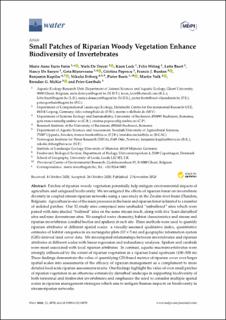| dc.contributor.author | Forio, Marie Anne Eurie | |
| dc.contributor.author | De Troyer, Niels | |
| dc.contributor.author | Lock, Koen | |
| dc.contributor.author | Witing, Felix | |
| dc.contributor.author | Baert, Lotte | |
| dc.contributor.author | de Saeyer, Nancy | |
| dc.contributor.author | Risnoveanu, Geta | |
| dc.contributor.author | Popescu, Cristina | |
| dc.contributor.author | Burdon, Francis J. | |
| dc.contributor.author | Kupilas, Benjamin | |
| dc.contributor.author | Friberg, Nikolai | |
| dc.contributor.author | Boets, Pieter | |
| dc.contributor.author | Volk, Martin | |
| dc.contributor.author | McKie, Brendan G. | |
| dc.contributor.author | Goethals, Peter | |
| dc.date.accessioned | 2021-05-31T10:43:09Z | |
| dc.date.available | 2021-05-31T10:43:09Z | |
| dc.date.created | 2021-03-10T15:52:59Z | |
| dc.date.issued | 2020 | |
| dc.identifier.citation | Water. 2020, 12 (11), 3070. | en_US |
| dc.identifier.issn | 2073-4441 | |
| dc.identifier.uri | https://hdl.handle.net/11250/2757034 | |
| dc.description.abstract | Patches of riparian woody vegetation potentially help mitigate environmental impacts of agriculture and safeguard biodiversity. We investigated the effects of riparian forest on invertebrate diversity in coupled stream-riparian networks using a case study in the Zwalm river basin (Flanders, Belgium). Agriculture is one of the main pressures in the basin and riparian forest is limited to a number of isolated patches. Our 32 study sites comprised nine unshaded “unbuffered” sites which were paired with nine shaded “buffered” sites on the same stream reach, along with five ‘least-disturbed’ sites and nine downstream sites. We sampled water chemistry, habitat characteristics and stream and riparian invertebrates (carabid beetles and spiders) at each site. Three methods were used to quantify riparian attributes at different spatial scales: a visually-assessed qualitative index, quantitative estimates of habitat categories in six rectangular plots (10 × 5 m) and geographic information system (GIS)-derived land cover data. We investigated relationships between invertebrates and riparian attributes at different scales with linear regression and redundancy analyses. Spiders and carabids were most associated with local riparian attributes. In contrast, aquatic macroinvertebrates were strongly influenced by the extent of riparian vegetation in a riparian band upstream (100–300 m). These findings demonstrate the value of quantifying GIS-based metrics of riparian cover over larger spatial scales into assessments of the efficacy of riparian management as a complement to more detailed local scale riparian assessments in situ. Our findings highlight the value of even small patches of riparian vegetation in an otherwise extensively disturbed landscape in supporting biodiversity of both terrestrial and freshwater invertebrates and emphasize the need to consider multiple spatial scales in riparian management strategies which aim to mitigate human impacts on biodiversity in stream-riparian networks. | en_US |
| dc.language.iso | eng | en_US |
| dc.publisher | MDPI | en_US |
| dc.rights | Navngivelse 4.0 Internasjonal | * |
| dc.rights.uri | http://creativecommons.org/licenses/by/4.0/deed.no | * |
| dc.title | Small Patches of Riparian Woody Vegetation Enhance Biodiversity of Invertebrates | en_US |
| dc.type | Peer reviewed | en_US |
| dc.type | Journal article | en_US |
| dc.description.version | publishedVersion | en_US |
| dc.rights.holder | © 2020 by the authors | en_US |
| dc.source.pagenumber | 21 | en_US |
| dc.source.volume | 12 | en_US |
| dc.source.journal | Water | en_US |
| dc.source.issue | 11 | en_US |
| dc.identifier.doi | 10.3390/w12113070 | |
| dc.identifier.cristin | 1897063 | |
| dc.relation.project | Norges forskningsråd: 264499 | en_US |
| dc.source.articlenumber | 3070 | en_US |
| cristin.ispublished | true | |
| cristin.fulltext | original | |
| cristin.qualitycode | 1 | |

